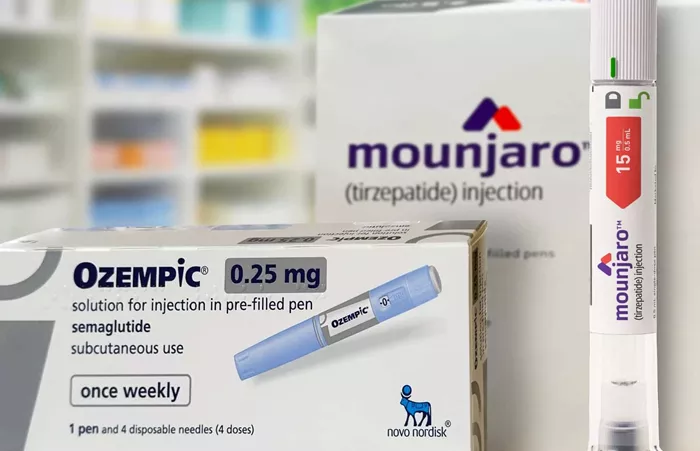In the realm of diabetes management, two medications have recently garnered significant attention: Ozempic and Mounjaro. Both are used to treat type 2 diabetes, but they operate through different mechanisms and offer distinct benefits. Understanding the differences between these two medications is crucial for healthcare providers, patients, and anyone interested in diabetes management.
Type 2 Diabetes and Its Management
Type 2 diabetes is a chronic condition characterized by insulin resistance and high blood glucose levels. Effective management of type 2 diabetes is essential to prevent complications such as cardiovascular disease, neuropathy, and nephropathy. Treatment typically involves lifestyle changes, oral medications, and injectable therapies. Ozempic and Mounjaro are two such injectable therapies that have emerged as significant players in diabetes management.
Ozempic: Overview
Ozempic, generically known as semaglutide, belongs to a class of medications called glucagon-like peptide-1 (GLP-1) receptor agonists. GLP-1 is a hormone that plays a crucial role in glucose metabolism by enhancing insulin secretion, reducing glucagon release, and slowing gastric emptying. By mimicking the effects of GLP-1, Ozempic helps to lower blood glucose levels in individuals with type 2 diabetes.
Mounjaro: Overview
Mounjaro, the brand name for tirzepatide, is a newer medication in the same category as Ozempic. However, it is a dual agonist, meaning it targets both GLP-1 and glucose-dependent insulinotropic polypeptide (GIP) receptors. GIP is another hormone involved in glucose regulation, and its activation has been shown to enhance insulin secretion and improve glycemic control.
Comparative Analysis
Mechanism of Action
Ozempic: As a GLP-1 receptor agonist, Ozempic primarily functions by:
Enhancing insulin secretion in response to meals.
Suppressing glucagon release from the pancreas, which helps to reduce hepatic glucose production.
Slowing gastric emptying, which leads to a more gradual rise in blood glucose levels after eating.
Mounjaro: Mounjaro’s dual-action mechanism includes:
Activating GLP-1 receptors, similar to Ozempic, to increase insulin release and decrease glucagon levels.
Activating GIP receptors, which contributes to enhanced insulin sensitivity and further improves glycemic control.
Efficacy
Ozempic: Clinical studies have demonstrated that Ozempic effectively lowers HbA1c levels, which is a key marker of long-term glucose control. In addition to its glucose-lowering effects, Ozempic has shown potential benefits in weight reduction and cardiovascular risk reduction.
Mounjaro:Emerging data suggest that Mounjaro may provide superior blood sugar control compared to other GLP-1 receptor agonists, including Ozempic. Mounjaro’s dual agonist properties are thought to provide a more comprehensive approach to managing blood sugar levels. Additionally, Mounjaro has demonstrated superior weight loss performance, which may exceed the effects of Ozempic.
See also: Can Weight-Loss Injections Solve the Obesity Crisis?
Safety Overview
Ozempic: Common side effects of Ozempic include nausea, vomiting, diarrhea and abdominal pain. These gastrointestinal symptoms are usually transient and improve over time. There are also concerns about potential risks such as pancreatitis and thyroid C-cell tumors, although these conditions are rare.
Mounjaro: The safety of Mounjaro has yet to be determined, but early studies suggest it shares some side effects with other GLP-1 receptor agonists, including gastrointestinal problems. Mounjaro’s dual mechanism of action may also affect its side effects, and continued research is critical to understanding its long-term safety impact.
Dosage and Administration
Ozempic: Ozempic is administered once weekly by subcutaneous injection. Dosages usually start at 0.25 mg per week and can be increased to 1 mg or 2 mg per week based on patient need and tolerance.
Mounjaro: Mounjaro can also be given by subcutaneous injection, but may be available in different dosing schedules and strengths. Current recommendations are that the starting dose should be increased gradually, similar to Ozempic, to minimize side effects and improve efficacy.
Cost and Accessibility
Ozempic: The price of Ozempic is an important factor for many patients to consider. The drug is available through various insurance plans, but the out-of-pocket costs may still be high for some patients.
Mounjaro: As a newer drug, Mounjaro may be initially priced higher. Its accessibility and insurance coverage will evolve over time as its long-term benefits and safety are further validated.
conclusion
In summary, Ozempic and Mounjaro represent two advanced treatment options for type 2 diabetes, each with unique mechanisms and benefits. Ozempic is a well-established GLP-1 receptor agonist with proven efficacy in glycemic control and weight management. Mounjaro uses a dual agonist approach, offering a promising alternative with the potential to enhance glycemic control and weight loss.
“While both medicines are valuable tools for diabetes management, the choice between Ozempic and Mounjaro will depend on individual patient needs, response to therapy, and overall treatment goals. Ongoing research and clinical experience will continue to shape the understanding of these medicines and guide healthcare professionals in optimizing diabetes care for their patients.”
Related articles:
What is Insulin-Dependent Diabetes: A Comprehensive Guide
Your Guide to Insulin: A Lifeline for Diabetes Management
How Are Type 1 & 2 Diabetes Similar?


